The Kidron Valley is a hidden treasure outside the Old City of Jerusalem which in the spring is carpeted with wild flowers.
From the street you cannot tell it is there, but if you walk outside Dung Gate after leaving the Western Wall, cross the street, and look down you will find it.
If you look around, you’ll find an inconspicuous staircase that leads you down to the valley.
The Kidron Valley is located between the Temple Mount and the Mount of Olives and continues north into the Judean Desert towards the Dead Sea.
The upper section that most people think of when they refer to the Kidron Valley is referred to as Valley of Yehoshafat (Jehosaphat) or the King’s Valley and is a necropolis!
In ancient times this area was considered part of the Mount of Olives and tombs in the valley date back to the First Temple and Second Temple periods.
During the Second Temple period, this was actually the main burial grounds of Jerusalem, where hundreds of tombs have survived.
In fact, there are three in particular that are especially well preserved.
Tomb of Absalom
The Tomb of Absalom, or Absalom’s Pillar, or Yad Avshalom is an ancient rock-cut tomb with a conical roof.
During the Middle Ages Christian pilgrims mistakenly deduced that this was Absalom’s Pillar – a tombstone built by Absalom, the son of King David.
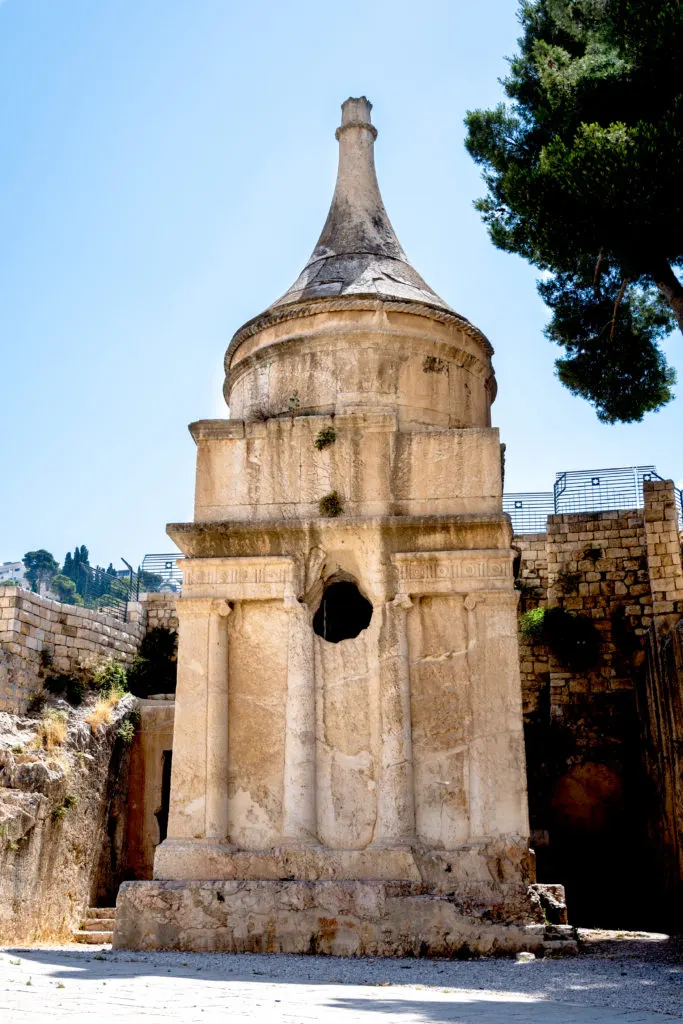
It was not uncommon for Christian pilgrims and Crusaders made these kinds deductions.
They also assumed the Tower of David was King David’s palace, but it is actually a citadel built over 2,000 years later. In fact, King David’s palace was discovered in the City of David, located just above the Kidron Valley.
Despite the mistake the name stuck, and is still used to this day, even though we know the tomb was built during the late Second Temple period and 1,000 years after Absalom existed.
In fact, modern scholars believe that may actually be the tomb of King Agrippa, Herod’s grandson.
In part, this is because the nearby Jehoshaphat Cave is a very large and ornamented cave that was used for family burial.
Jehoshaphat Cave
The Jehoshaphat Cave is a burial cave believed by some to be the resting place Agrippa’s family members and that Agrippa and his wife are entombed in the so called “Tomb of Absalom.”
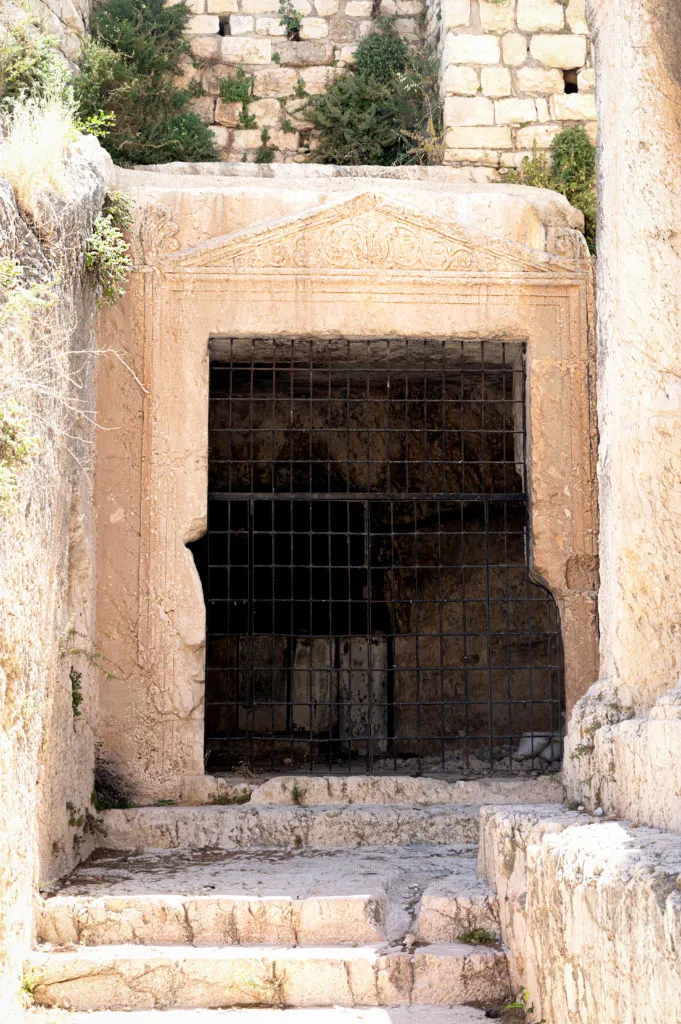
The tombstone was hewn from the surface of the cliff with one side facing out, while the other three sides are surrounded by bedrock.
The lower section of the tombstone was quarried and the upper section was contracted.
The quarrying style combines a variety of architectural traditions characterizing Jewish art of the late Second Temple period.
The tombstone consists of two main parts. The lower part, which was hewn from the bedrock, and the upper part, built of ashlars .
The main structure is decorated classic Greek elements like ionic styled pillars and a doric frieze (the decorative band above the pillars). However, it also features an Egyptian cornice (decorative moulding that crowns a building).
The upper section has a rope-like decoration on the bottom of carved cone. The tippy top is a stone hewn in the shape of a lotus flower with six petals. There may have been something placed inside the socket.
Tomb of Benei Hezir
The Tomb of Benei Hezir dates to the Hasmonean period, and is hewn entirely inside the cliff is and the oldest of four monumental rock-cut tombs in the Kidron Valley.
A Hebrew inscription above the cave indicates that a family of priests from Benei Hezir is buried in the cave.
“This is the grave and the Nefesh of Eliezer Hania Yoazar and Yehuda Shimon Yochanan sons of Yosef son of Oved Yosef and Elazar sons of Hania, Kohanim of the Hezir family.”
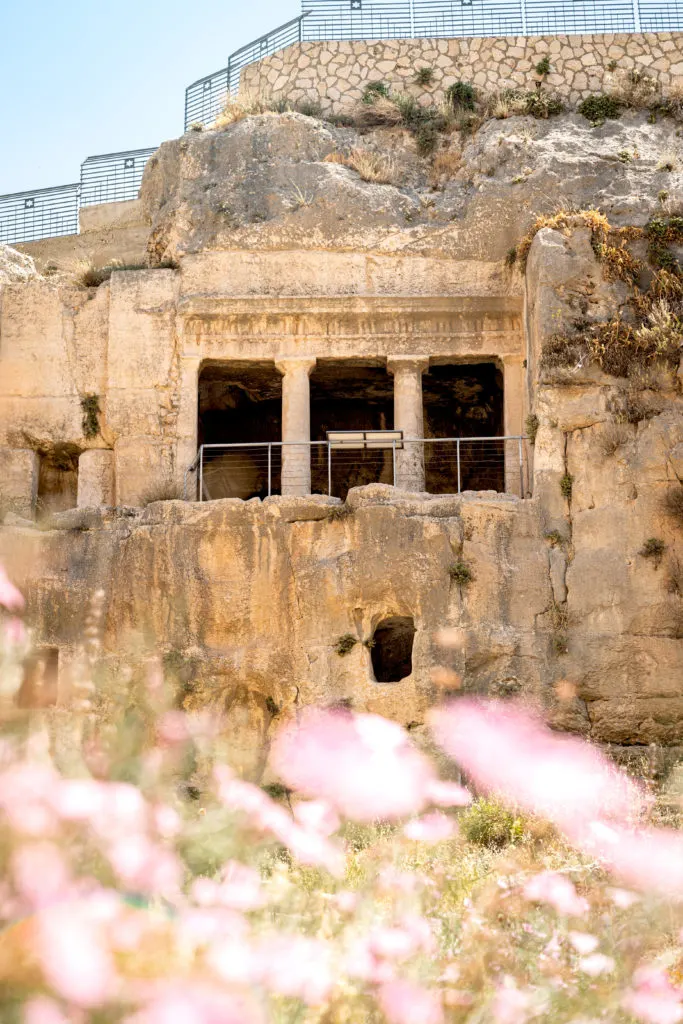
The tomb’s inscription shows that the cave was used by several generations of the Benei Hezir family.
In the Hebrew Bible, there are two mentions of men with the name of Hezir.
One was the founder of the 17th priestly division (1 Chron. 24:15). The other one was among the leaders who set their seal to the covenant with Nehemiah (Neh. 10:20).
It is not certain if there is a relation between the family buried in the Tomb of Benei Hezir and the biblical Hezirs.
The inscription mentions a nefesh, which means “soul” in Hebrew, but is also a burial monument, which is what it means here.
It has been proposed that the Tomb of Zechariah is actually this nefesh.
Another option is that the additional façade to the north of the Doric dystilos-in-antis was the original nefesh.
Having a nefesh in front of a tomb was popular in the Second Temple Period among the rich.
The architectural style of the hewn elements, particularly the capitals of the columns, is inspired by Greek architecture.
Unlike the other tombstones nearby, the Tomb of the Sons of Hezir is made entirely in a uniform Greek style, without mixing different styles or Roman influences.
Tomb of Zechariah
The Tomb of Zechariah is an ancient stone monument adjacent to the Tomb of Benei Hezir.
It is believed by many to be the tomb of the cohen (Temple priest) Zechariah ben Jehoiada.
However, it is a monolith, which means it is completely carved out of the solid rock and does not contain a burial chamber.
Also, Zechariah ben Jehoiada was from the First Temple Period, while this structor dates to the end of the Second Temple Period.
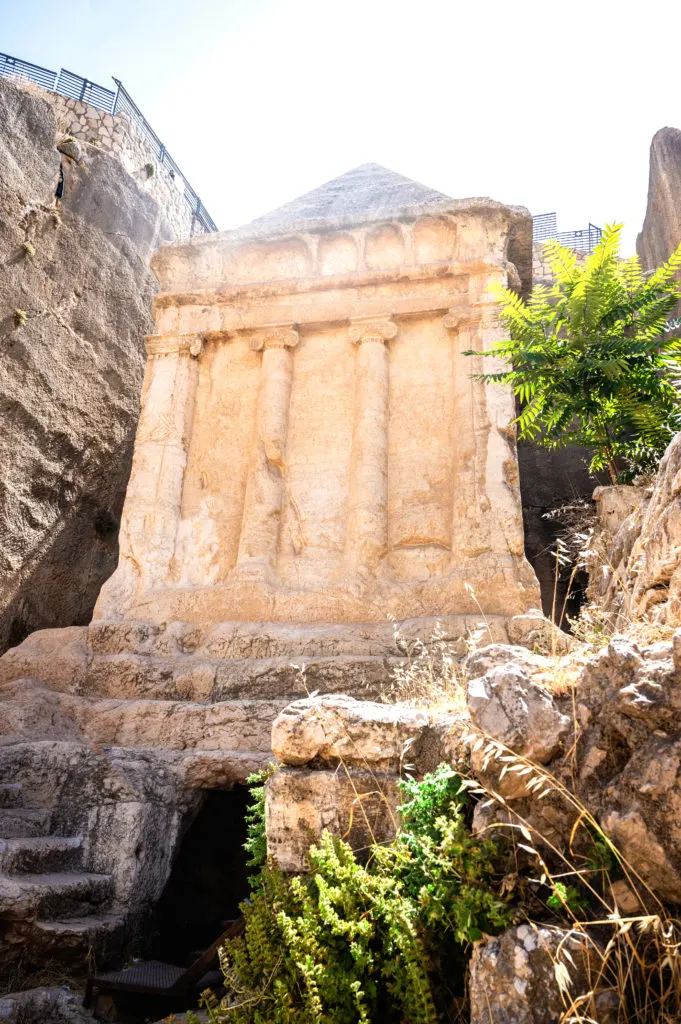
This is in fact a nefesh, which is a monument for a burial complex that commemorates the deceased and was popular among the elite during the Second Temple period.
Its style is similar to that of the Tomb of Benei Hezir, and making it likely that it is the nefesh which was noted to be located nearby.
Another opinion is that the nefesh of the grave had never itself been hewn for some reason – such as the Great Revolt.
The architectural elements are a mixture of styles. Greek ionic pillars are topped with a pyramidal roof and an Egyptian cornice bounded between them.
The facade has been inscribed by Jewish pilgrims from various periods.
The Mound of Rabbi Kalonymus the Miracle Worker
The Mound of Rabbi Kalonymus the Miracle Worker is where a mount of stones marks his burial place, a Jerusalem Rabbi who lived in the 16th century.
According to tradition, Rabbi Kalonymus’s piety miraculously saved the Jewish community from a blood libel planned by their gentile neighbors.
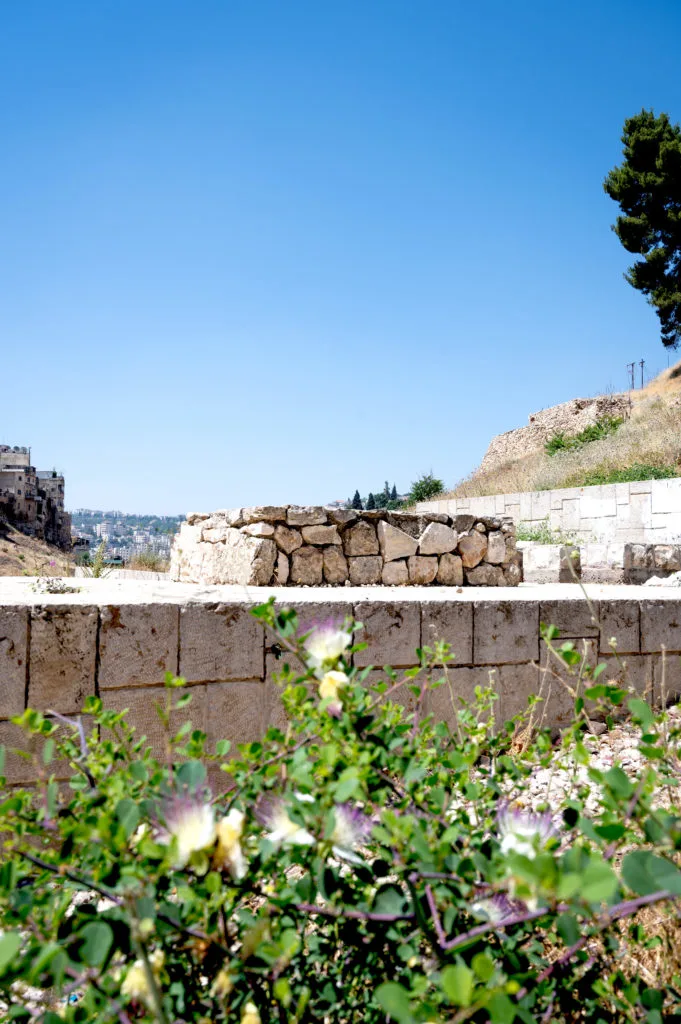
The holy Rabbi was forced to break Shabbos to save his fellow Jews. The transgression caused him such tremendous sorrow that on his deathbed, he requested from his community to bury him outside the Jewish cemetery.
There was no gravestone over his burial place, but rather a pile of stones that remained there for hundreds of years until it was destroyed by the Jordanians.
Tomb of Pharaoh’s Daughter
This is a tomb from the First Temple period, which is popularly known as the Tomb of Pharaoh’s Daughter.
The name comes from the fact that it was once topped with a stone pyramid, so it has been believed to have been the Tomb of King Solomon’s Egyptian wife.
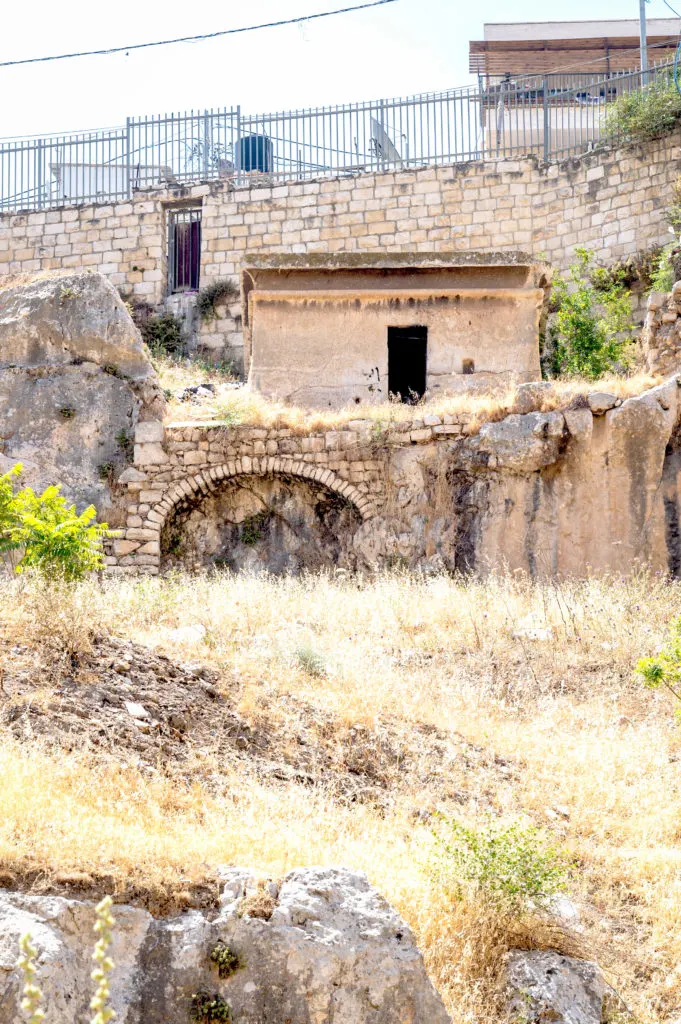
However, the pyramid was cut into pieces and removed for quarry during the Roman Period, leaving a flat roof.
First Temple Burial Caves
You can see First Temple burial caves hewn into the cliff beneath the modern village of Silwan, and many more are scattered among the houses.
They were carved out of the rock for the nobles of Jerusalem in the First Temple period.
In the picture below you can see them as square holes in the stone under the apartments.
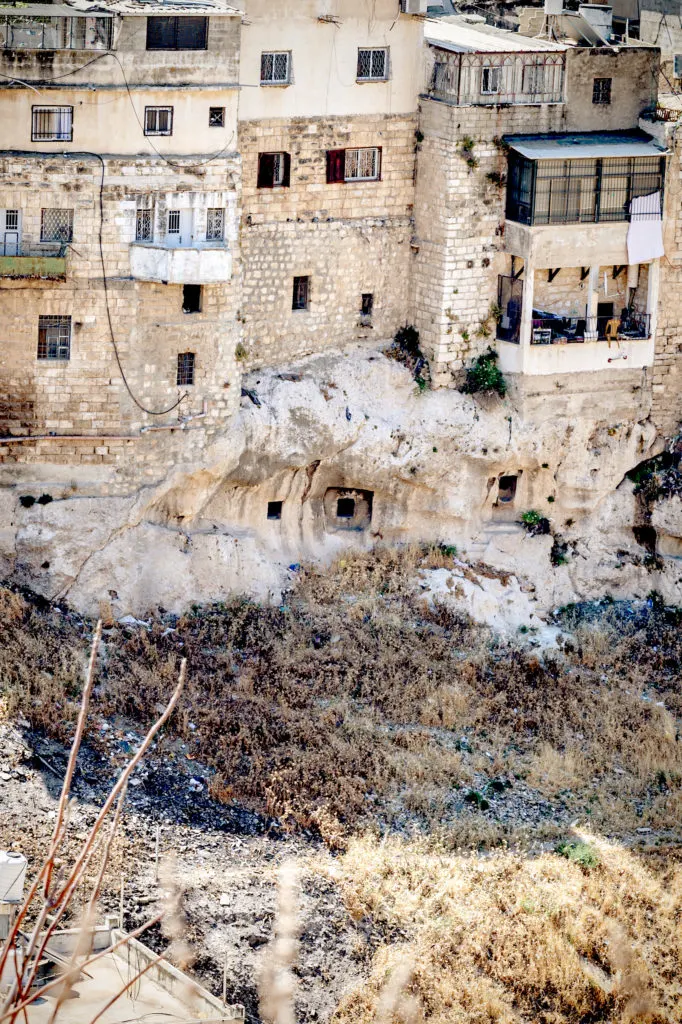
How to Get to the Kidron Valley
Walking
From Dung Gate located near the Western Wall, cross the street and walk down towards the City of David.
Continue walking down the road as it curves to the left until you see the stairs on the right going down to Absalom’s Tomb.
By Car
Street parking near the Mount of Olives Information Center located at 5 Derech Jericho, Jerusalem.
Take the stairs down to the Kidron Valley.
By Bus
From the Central Bus Station
Take bus line 1 or 3 in the direction of the Western Wall.
Get off three stops before the Western Wall at the stop called Derech Jericho/Derech HaOfel.
Make your way towards the traffic light and cross the street at the crosswalk.
Continue towards the cemetery (until just after the large church).
On the right hand side, you will see a large Israeli flag and the Mount of Olives Information Center.
Take the stairs down to the Kidron Valley.
From the Old City
Take line 83/83a or 51 towards Mount of olives. Get off at the bus stop called Har-Hazetim that is right to the Information center.
Take the stairs down to the Kidron Valley.
First Station Free Shuttle Service:
You can take the free shuttle from the First Station service to Dung Gate in the Old City.
From there, you cross the street and walk down towards the City of David.
Continue walking down the road as it curves to the left for about 30 meters until you see the stairs on the right going down to Absalom’s Tomb.
See the First Station website for shuttle hours.